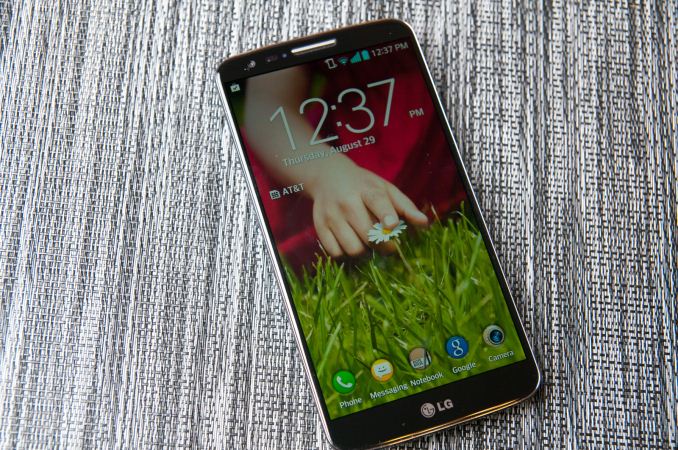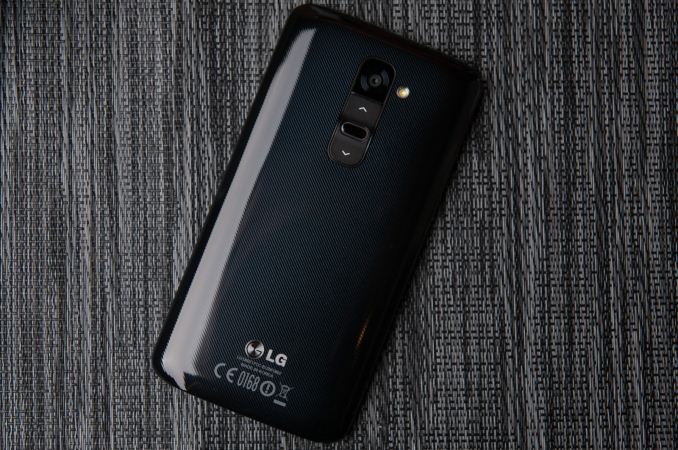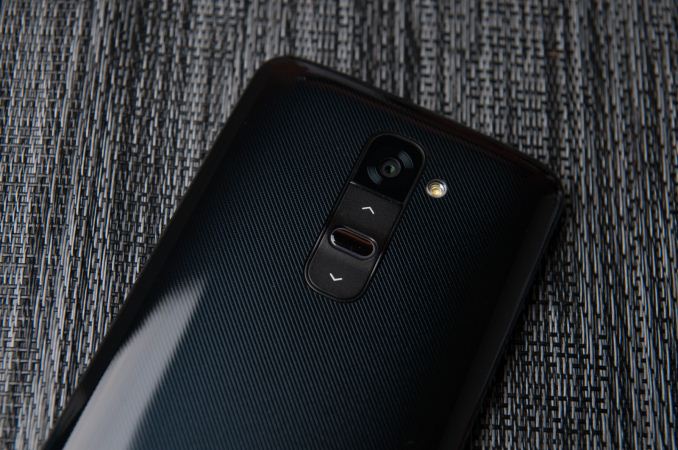LG G2 and MSM8974 Snapdragon 800 - Mini Review
by Brian Klug on September 7, 2013 1:11 AM EST- Posted in
- Smartphones
- LG
- Mobile
- LG G2
- Android 4.2
- MSM8974
- Snapdragon 800

The LG G2 is the spiritual successor to the Optimus G, a device that we looked at last year and eventually went on to become the Nexus 4. LG dropped the "Optimus" branding this time, but the G2 is without a doubt still LG's flagship smartphone, and includes a number of unique LG features – stacked 3000 mAh (11.4 Whr) battery with SiO+ anode, 5.2-inch 1080p LCD from LG Display, and 13 MP rear facing camera with OIS (Optical Image Stabilization). It's an impressive combination of features that make the G2 a standout device. At the same time the G2 is our first chance to get a look at the 2.3 GHz bin of Snapdragon 800 inside a shipping device and get a look at performance and battery life.
We took a quick look at the G2 at the announcement event, now we have our hands on a G2 and have been putting it through its paces, benchmarking it, and running battery life tests on it for a little under a week and wanted to share some thoughts.
Hardware Impressions
The G2 marries a curved backside shape with front glass that slightly curves at the edges and has a very narrow side bezel. The G2 also opts for on-screen buttons rather than the discrete capacitive kind or physical buttons that went out of favor a while ago. The reality is that Google does have a fair amount of input into at least this part of the Android ecosystem, and its guidance seems to be that on-screen buttons which use display real estate to draw the buttons is the recommended way to go. The G2 does afford the ability however to add Quick Memo buttons or the notification shade pull down/pull up buttons to the bar, but oddly enough there's no multitasking button option available.
The G2 manages to include a large display without width that's much different from other devices I've been using lately, like the HTC One. Part of getting the edge bezel small was a reduction in volume required on the sides for volume and power buttons, which are instead moved to the back of the G2, perhaps its most striking and initially even alarming design change.
Holding down the volume down button launches you into the camera, pressing the center button powers on the phone, and holding down the top button launches QuickMemo. Up and down are volume up and down otherwise. There's a hard raised lip on both sides of the button too, so the G2 when laid backside down on a surface makes contact there instead of on the button – it won't inadverntely turn on when pressed against a table. I found the backside buttons easy to adapt to after my first few interactions with the G2, and they actually become second nature after a day or so. The raised bump for the power button makes it easy to locate with the index finger, and I haven't smeared or accidentally put my finger on the sapphire camera cover yet. If the power button on the back is still difficult to get used to, the G2 has a double tap to turn on feature it calls "knock knock" – double tap on the display, and the G2 will turn on, repeat the double tap on the status bar or in an empty part of the display when it's on, and it turns off. I find myself using the double tap gesture quite a bit to turn the G2 on and off. I believe this functionality uses the sensors onboard and the DSP inside 8974 to detect when the taps occur.
The G2 I was sampled is a dark blue color which has a slight pinstripe on the back as shown in the photos above. The material is however the same kind of glossy plastic I'm used to seeing out of the Korean handset makers of note, and picks up fingerprints and hand oil very quickly unfortunately. I like the shape of the device and LG's innovations, it's just puzzling to me that materials hasn't picked up yet, I'd even take glass from the Optimus G over plastic. I'll save you the huge discussion on device size as well, I'm fine with the larger smartphones that aren't quite phablets, and the G2 for me is totally usable and I appreciate the increased display size. It definitely isn't phablet size, but it is on the larger high-end smartphone side of things.
| LG G2 | |
| SoC |
Qualcomm Snapdragon 800 (MSM8974) 4x Krait 400 2.3 GHz, Adreno 330 GPU |
| Display | 5.2-inch IPS-LCD 1920x1080 Full HD |
| RAM | 2GB LPDDR3 800 MHz |
| WiFi | 802.11a/b/g/n/ac, BT 4.0 |
| Storage | 32 GB internal |
| I/O | microUSB 2.0, 3.5mm headphone, NFC, Miracast, IR |
| OS | Android 4.2.2 |
| Battery | 3000 mAh (11.4 Whr) 3.8V stacked battery |
| Size / Mass | 138.5 x 70.9 x 9.14 mm |
| Camera |
13 MP with OIS and Flash (Rear Facing) 2.1 MP Full HD (Front Facing) |



















120 Comments
View All Comments
Impulses - Saturday, September 7, 2013 - link
I've got an EVO LTE but I'm on a similar boat, furthermore, this is the first tine in three years where I'm just not in a hurry to upgrade. Going to dual cores and 1GB of RAM was huge (EVO to EVO 3D), going from qHD to 720p and a much thinner device last year was also huge (not to mention ICS/JB)... Right now there's no hugely compelling hardware/software reason urging me to upgrade tho. I still might if this comes out as a Nexus 5 for $350 tho...RollingCamel - Saturday, September 7, 2013 - link
What about the audio codecs LG claimed support for? Did you try FLAC on it?maglito - Monday, September 9, 2013 - link
FLAC has native support on every 4.X android device.shackanaw - Monday, September 9, 2013 - link
He's referring to the 24-bit/192khz support and other improvements mentioned in the G2 hands on: http://www.anandtech.com/show/7205/hands-on-with-t..."LG has made audio in the line-out sense a priority for the G2. We’ve seen a lot of emphasis from other OEMs on speaker quality and stereo sound, with the G2 LG has put time into rewriting part of the ALSA stack and Android framework to support higher sampling and bit depth. The inability of the Android platform to support different sampling rates for different applications remains a big limitation for OEMs, one LG wrote around, and with the G2 up to 24 bit 192 kHz FLAC/WAV playback is supported in the stock player, and LG says it will make an API available for other apps to take advantage of this higher definition audio support to foster a better 24-bit ecosystem on Android.
"I asked about what codec the G2 uses, and it turns out this is the latest Qualcomm WCD part, which I believe is WCD9320 for the MSM8974 platform. LG says that although the previous WCD9310 device had limitations, the WCD9320 platform offers considerably better audio performance and quality that enables them to expose these higher quality modes and get good output. The entire audio chain (software, hardware codec, and headphone amplifier) have been optimized for good quality and support for these higher bit depths, I’m told. I didn’t get a chance to listen to line out audio, but hopefully in testing this emphasis will play itself out."
tuxRoller - Tuesday, September 10, 2013 - link
24bit playback is a gimmick since even the studio equipment, apparently, doesn't handle the full 24bit. Aside from that, you just don't need that much sample accuracy unless you're superman.http://xiph.org/~xiphmont/demo/neil-young.html
ssj3gohan - Saturday, September 7, 2013 - link
Why are the iPhone raw triangle/fill rate tests so much better than any other phone, yet does it perform middle of the pack in gfxbench and such? I was under the impression that they basically had the best graphics solution around, paired with awesomely optimized software.et20 - Saturday, September 7, 2013 - link
Apparently they didn't optimize for gfxbench.UpSpin - Saturday, September 7, 2013 - link
The meaningless synthetic benchmarks always favored iOS. The reason many people think that iPhones are magnitudes more powerful than Android devices.The only meaningful benchmarks are normal 3D scenes.
I don't understand why Anandtech still posts those meaningless benchmarks. Or can you read something out of them? NO! They are in no way a measurement for performance. They are basically useless. That's the reason we don't see them on desktop GPU comparisons.
tuxRoller - Saturday, September 7, 2013 - link
They give you a good idea of the device's capabilities in specific areas. Useful for doing a deep dive to determine what the make-up of the device is.For realworld use, you are absolutely right, and, imho, such synthetics only belong in articles where there are new components (like this one), but for the next snapdragon-800, I don't think those particular benchmarks need be run..
Krysto - Sunday, September 8, 2013 - link
Sunspider also seems pretty pointless at this point. Kraken and Octane seem to give more accurate results in terms of chip performance.